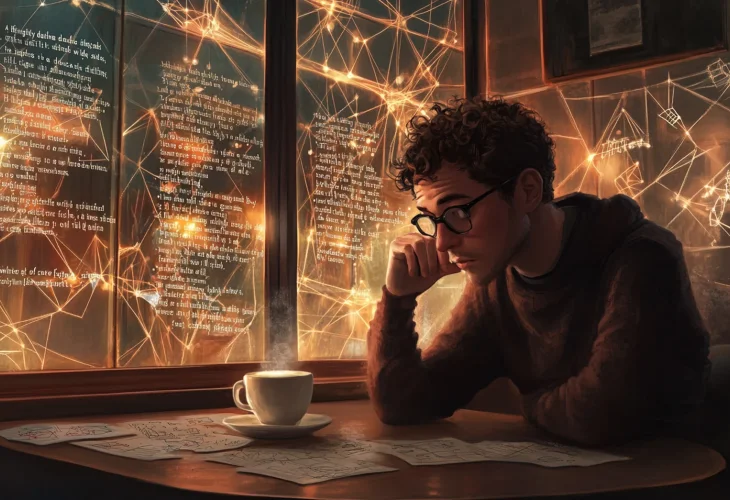A Blow to the Head Unveils a Genius: How Jason Padgett Discovered His Cosmic Consciousness
After a violent mugging left him with a severe concussion, Jason Padgett awoke to a transformed self, seeing the world through the lens of geometry and mathematical beauty.

Jason Padgett, at 31, dressed and groomed himself for a night out with friends in Tacoma, Washington. Near midnight, he left them momentarily to grab a cool drink from a kiosk. He noticed the vendor's long glance at his bulging wallet but dismissed any concern; it was filled with nothing more than twenty-dollar bills. Gulping down his soda, he moved toward the club's exit.
Just steps outside the door, he felt a severe blow to his head, sending him to his knees. Initially, he thought it might be a drunken friend's clumsy prank, but the hits kept coming. Amid the haze of his fading consciousness, he felt hands rummaging through his coat pockets. When his attackers couldn't find his wallet, they vented their frustration with more punches and kicks until he heard their footsteps retreating.
Slowly regaining consciousness, Jason managed to stagger to his car, puzzled by his friends' absence. Fortunately, the hospital was nearby. There, he learned he had a severe concussion; the doctor prescribed painkillers and sent him home. Jason had no idea that after that violent encounter, a new self emerged, leaving his old identity at the kiosk's entrance.
"The next morning, everything around me looked different," Padgett shared in an interview with Epoch Times. "I thought the medication might be causing hallucinations." He describes his new vision of the world with contagious enthusiasm, speaking rapidly and with excitement.
When he turned on the bathroom faucet, he saw a spectrum of colored rays emanating perpendicularly from the water stream, spilling into what seemed like infinity. The tree leaves outside the window looked like an infinite collection of tiny connected triangles.
Trying to shake off what seemed like hallucinations, he made himself a cup of coffee. As he poured the milk, he observed it swirling into the coffee in diminishing circles, interlocking with exquisite order like a seashell. His entire apartment and the objects within it transformed into a collection of geometric shapes.
Padgett was convinced something was amiss in his brain, not just visually but physically, experiencing intense pain and involuntary body tremors. A follow-up brain scan showed no trauma, and doctors reassured him that these symptoms would eventually subside.
But the symptoms persisted. To him, everything appeared as a complex geometric pattern, gradually captivating him with its infinite complexity and beauty. He grew curious about others who experienced head trauma. Did it change their perception too?
From a college dropout interested only in social life, he morphed into an autodidactic researcher, consumed by a passion to understand everything related to mathematics, primarily geometry.
His journey is detailed in his book "Struck by Genius," published in April 2014 in the US. For four years, Padgett lived isolated in his dim apartment, which he perceived as a magical cave. The ever-present geometric shapes and his online learning led him to realize he was visually perceiving mathematical formulas explaining universal phenomena. The tree's leaf triangles displayed Pythagorean theorems repeatedly, and their intersection with sunlight appeared as slices of "pi," the transcendental number beginning with 3.141592. The milk's swirling circles in his coffee mirrored the fractal world formula by mathematician Benoît Mandelbrot: endlessly repeated forms in nature, shrinking tinier yet maintaining their complete structure. Padgett saw the entirety in any small part he examined: a tree leaf, ripples in water, clouds, and the human body.
One day, after four years of self-imposed "captivity," like a fairy tale unfolding, Padgett's phase ended suddenly. He craved a beef roast sandwich, overcoming his fear to visit a nearby mall café. Cautiously, he took his prized drawings. At the café, he laid out his art while awaiting his sandwich. An intrigued man at a nearby table asked about them; Padgett eagerly explained his geometric worldview.
"He introduced himself as a local university physicist," Padgett noted in his book. Astounded by Padgett's explanation, the man remarked, "You've grasped very complex concepts but lack the formal education to articulate them. Consider studying them."
Berit Brogaard, a professor of neuroscience and philosophy at the University of Missouri-St. Louis and head of a multisensory research lab, met Padgett at a Stockholm international synesthesia conference. Attendees included those experiencing blended senses, like seeing numbers or letters as colors or tasting music. Padgett's case stood out uniquely: his brain translated abstract mathematical concepts into visual representations, and this skill developed later in life, as most synesthetes are born with such abilities.
Miraculously and unexpectedly, the mugging gifted Jason with profound empathy towards all humanity. "This empathy surfaced alongside my newfound abilities. I acutely sense others' emotions, pain, and discomfort along with my own feelings. Witnessing anyone in distress is unbearable to me."
Jason's deep emotional connection with humanity aligns with his belief in our interconnected cosmos. "Humans are interwoven with the universe's geometric designs. You, I, the trees, the cosmos—we're all part of something bigger. I once felt separate from others and the universe, but now see it differently. Like a cell is part of a body, we all belong to a greater system. Everything we do impacts the whole..."
The universe is intricately crafted by the Creator, with the human mind capable of perceiving glimpses of its wonders—unity of nature's laws and human souls. A minor shift can awaken awareness, enabling us to understand far more.

